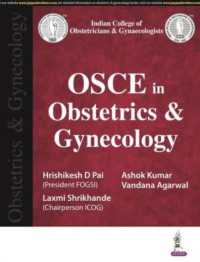- ホーム
- > 洋書
- > 英文書
- > Science / Mathematics
Full Description
Howler monkeys (genus Alouatta) comprise 12 species of leaf-eating New World monkeys that range from southern Mexico through northern Argentina. This genus is the most widespread of any New World primate and can be found to inhabit a range of forest types from undisturbed rainforest to severely anthropogenically-impacted forest fragments. Although there have been many studies on individual species of howler monkeys, this book is the first comprehensive volume that places information on howler behavior and biology within a theoretical framework of ecological and social adaptability. This is the first of two companion volumes devoted to the genus Alouatta.
This volume:
· Provides new and original empirical and theoretical research on howler monkeys
· Presents evolutionary and adaptive explanations for the ecological success of howler monkeys
· Examines howler behavior and ecology within a comparative framework
These goals are achieved in a collection of chapters written by a distinguished group of scientists on the evolutionary history, paleontology, taxonomy, genetics, morphology, physiology, and anatomy of howlers. The volume also contains chapters on howlers as vectors of infectious diseases, ethnoprimatology, and conservation.
Contents
Part 1. Introduction.- Chapter 1. Why is it Important to Continue Studying the Anatomy, Physiology, Sensory Ecology, and Evolution of Howler Monkeys?.- Part 2. Taxonomy, Genetics, Morphology and Evolution.- Chapter 2. Fossil Alouattines and the Origins of Alouatta: Craniodental Diversity and Interrelationships.- Chapter 3. The Taxonomy of Howler Monkeys: Integrating Old and New Knowledge from Morphological and Genetic Studies.- Chapter 4. Cytogenetics of Howler Monkeys.- Chapter 5. Hybridization in Howler Monkeys: Current Understanding and Future Directions.- Chapter 6. Morphology of Howler Monkeys: A Review and Quantitative Analyses.- Part 3. Physiology.- Chapter 7. Hematology and Serum Biochemistry in Wild Howler Monkeys.- Chapter 8. Endocrinology of Howler Monkeys: Review and Directions for Future Research.- Chapter 9. The Howler Monkey as a Model for Exploring Host-Gut Microbiota Interactions in Primates.- Chapter 10. Ecological Determinants of Parasitism in Howler Monkeys.- Part 4. Ontogeny and Sensory Ecology.- Chapter 11. An Ontogenetic Framework for Alouatta: Infant Development and Evaluating.- Chapter 12.The Sensory Systems of Alouatta: Evolution with an Eye to Ecology.- Chapter 13. Production of Loud and Quiet Calls in Howler Monkeys.- Chapter 14. Function of Loud Calls in Howler Monkeys.- Part 5. Conclusions.- Chapter 15. New Challenges in the Study of Howler Monkey Anatomy, Physiology, Sensory Ecology, and Evolution: Where we are and where we need to go?.








